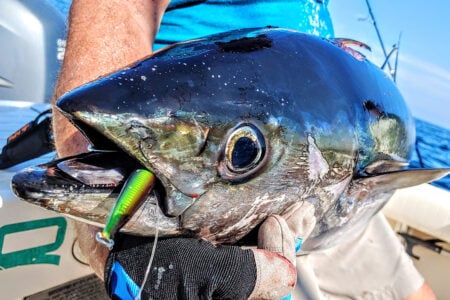
Jigging tuna while chunking is a great way to increase your chances of hooking up. On more than one occasion I have jigged up tuna during an otherwise quiet chunking session to salvage a trip. Sometimes you need change things up a bit to entice a strike. When tuna see something jetting through a slick of butterfish chunks they can’t resist chasing and inhaling it.
As jigging techniques were being developed for offshore fishing situations, many changes had to be made to accommodate this style of fishing. Jigs utilized in greater depths for larger prey in stronger currents began evolving to meet the more demanding conditions. The standard inshore jigs made by AVA, Bridgeport and Hopkins needed to be modified or to evolve into offshore ready models. Hooks had to be upgraded to heavy duty to avoid having them straightened by the stress of fighting large pelagics. Beefed up rigging of the jigs was also critical. Upgrading the strength of split rings, assist hooks, barrel swivels, and the wire that is molded through the jig was essential to ensure that these jigs stayed glued during lengthy battles with large fish. The weights of jigs are also a major factor when considering the depths and currents that they are deployed in.
You may find it too involved and expensive to try to re-rig existing models of standard jigs. Luckily, there have been several companies that offer their version of offshore ready jigs. Three stand-outs when it comes to jigging tuna are those made by Striker Tackle, Williamson and Shimano’s Butterfly Jigs. There are many sizes, colors and styles to choose from in the most popular sizes, which range from 150 to 300 grams (5 to 10 ounces).
Jigging Techniques
When considering a jig you should understand what it was designed to do and how it should be worked. When working shallower inshore waters, the preferred technique is to cast a 4-ounce diamond jig beyond fish holding structure and any fish being marked on the recorder. While retrieving, the angler constantly works the jig up and down several feet off the bottom until the jig is directly under the boat. This method will not work in 250 to 1,000 feet of water. There are many styles of jigging and each one has a preferred jig that performs best.
Vertical jigging is a simple method that is used to dart the lure straight up and straight down. You simply drop to the bottom (or to a depth just below marked fish) and crank the jig up as fast as you can. You should experiment with different retrieval methods. Whichever method you utilize, be prepared for a vicious strike and ensure the rod does not get ripped out of your hand. Often overlooked are the strikes on the way down. In this case, a fish may just inhale the jig and either sit on it, or swim toward the surface. Either way it is subtle and very hard to detect, but when it happens, engage the drag and reel as fast as you can. It takes practice to recognize these strikes. On the descent, you need to have control of the slack line as it slides down the water column. If the line slacks further, or acts different in any way, lock it up and reel. This is where the use of a hi-visibility line helps you detect those subtle changes in the movement of your line. Once you feel pressure set the hook. The type of hook on your jig dictates how you set it. If the jig is rigged with “J” hooks, once you feel the weight of the fish set the hook. If the jig employs circle hooks, just keep reeling through the pressure of the fish as the hook finds its purchase point and sets itself.
Types of Jigs
Diamond jigs are considered the industry standard. These four-sided jigs come in various finishes; shinny, hammered and enamel painted are most common. Hammered jigs are made to give off an erratic shine mimicking scales on a baitfish. Enamel painted lures come in many color combinations (including shiny scales) as well as nightglow finishes. This is typically a symmetrical lure that has a predictable action and is offered in various weights. A diamond jig can be effectively utilized with most jigging techniques. They can also be cast into a school of busting tuna and worked back like a plug. Be aware as you reel it closer to the boat, you don’t want to pull it out of the water and into the side of the boat, or worse. These jigs are also effective as trolling lures. They can either be deployed on transom clips just outside the wash, or as shotgun baits. When you hook up with your initial trolling spread, assign an angler the task of dropping a jig back into an empty spot in your spread. As you continue to troll for multiple hook ups, work the jig by jerking it back and forth.
Similar to the industry standard diamond jig is the three sided or flat back speed jig. These jigs are designed to mimic a darting squid with lightning blasts both up and down the strike zone. Available in various weights and enameled in myriad colors and designs, they are similar to the four sided jig but offer less resistance and a slightly sleeker profile. This jig is balanced in weight but not perfectly symmetrical. This will lead to some extra erratic action. They can be cast on the surface in a pinch, but the diamond jig is preferred for this method. The jig is engineered to fall fast to the bottom and be worked equally fast back through the strike zone, a technique referred to as yo-yo jigging.
A cousin to the flat back is the speed jig. This jig is designed as a two sided option that literally knifes its way through the water column. The sleekest of jig types, it is fastest to the bottom and offers little resistance as it is rifled back up. They are available in many of the same finishes and weights as flat back style jigs. Then there are jigs that fall into the “slow fall” category. These are designed to look like a stunned baitfish dropping and wobbling from side to side as they slide down into the deep. Engaging the reel and darting it towards the surface portrays a stunned fish that may have revitalized and started to run in a fleeing motion. These are great jigs to work when the fish are concentrated in a narrow strike zone. Many of the hits are on the fall, so you really need to pay attention and learn how to recognize these strikes. An angler can also switch to this lure when they need a break from speed jigging. When the lure is at the desired depth you can sweep it up with the rod and let it flutter down. Another popular option is to set a jig out in your outrigger. When drifting conditions are a little bumpy, the wave action will work the jig for you. Diamond jigs and flat back jigs can work but are not as effective when fished from an outrigger. These jigs are engineered for bursts of speed, up and down the water column. Dead sticking them in an outrigger doesn’t present them as intended. Slow fall jigs are a great option. The wave pulls the jigs up, and as the boat rocks back the jig falls slowly side to side like a wounded baitfish. The dead stick jigging rod should be on the chunking side of the boat. You want it working in the chunk slick. Also, after a hook up, you want to fight the tuna on the down current side of the boat. A fish hooked on the up current side tends to run with the current under the boat and can lead to a lost fish. Pay special attention to avoid tangling chunking lines with the jigging rod.
Jig Maintenance
Keeping your jigs clean and regularly inspected for any potential defects ensures long life and proper performance. After every use, clean them with warm, soapy water and dry prior to storage. If you notice that your finish discolors or stains you can use jewelry cleaner to bring back its luster. Read the product specific recommendations – normally a good soaking overnight does the trick. If you have access to a steam cleaner this is also a great option. Visually inspect and replace any defective hooks, split rings, barrel swivels, tubes etc.
Jigs can be rigged in many ways. The most common is with two assist hooks looped through a split ring at the top of the jig. When selecting a hook, pay attention to the jig’s width. The hook needs to be much larger or smaller than the jig. If they are too similar in size the hook can catch itself on the body of the jig preventing a proper hook up. When purchasing new jigs, find out what rigging options are available. In some tackle shops, you can get them rigged how you like for a slight up-charge, or opt for the unrigged option and do it yourself. Remember, you get what you pay for. Good quality jigs should last a lifetime, while cheap lures with inexpensive finishes may last just one trip.



